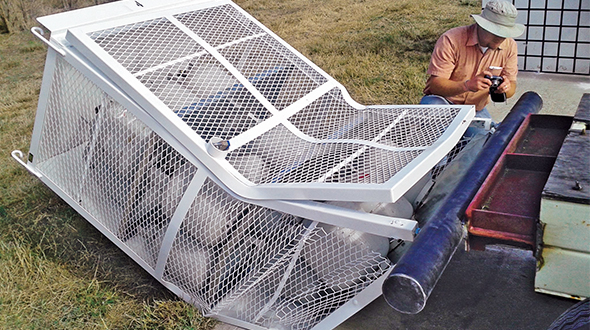Cylinder Exchange Council covers laws, regulations, technical issues

A research program conducted by the Cylinder Exchange Council included vehicle crash testing of metal cylinder cabinets. Photo courtesy of The National Propane Gas Association and The Propane Education & Research Council
The Cylinder Exchange Council is a business council that operates under the auspices of the National Propane Gas Association (NPGA). It was formed in the mid-1990s, and its membership is composed of NPGA members who are propane marketers, equipment manufacturers and service providers. It operates independently of any other NPGA committee, although it reports on its activities to the NPGA board of directors.
Cylinder Exchange Council leadership is provided by a six-member steering committee that rotates two members off annually. The steering committee elects a vice chairman every year, with the previous vice chairman ascending to the chairmanship for the coming year. This model has worked well for the council, as some projects require frequent oversight and quick decisions to be made.
The council is not a benchmarking group in the sense that it does not share sales or marketing data. Instead, it focuses on the laws, regulations and technical issues that are common to all companies in this branch of the propane industry.
Over the years, the Cylinder Exchange Council has undertaken several projects on the codes and standards used to regulate cylinder exchange operations.
NFPA 58 and the International Fire Code (IFC) are two of the most significant documents in which projects have resulted in changes to those codes, but the council also weighs in on federal regulations, such as those promulgated by the U.S. Department of Transportation.
Here are some of the council’s past projects:
-
- The council utilized the availability of Propane Education & Research Council (PERC) funding early in its history. One of the first successful research projects conducted by PERC resulted in the report entitled, “Investigation of Methods for Purging Propane Containers.” This study of an industry-wide process had its genesis in the Cylinder Exchange Council. The purpose was to develop and test a mathematical model for purging containers of air (which includes water vapor) so that any container could be purged using propane vapor at positive pressure.
- Another self-funded project occurring in the late 1990s involved a proposal to the IFC, which in the 2000 edition required a minimum outdoor cabinet separation distance of 20 ft. from exit doors. This restriction differed substantially from the requirements in NFPA 58, so the council funded the involvement of a code consultant that developed a proposal to bring the requirements of the IFC into closer alignment with NFPA 58. This effort proved successful. Since the 2006 edition of the IFC, the requirements for separation of cylinder exchange cabinets have been closely aligned with those in NFPA 58.
- During the development of the 2012 edition of the IFC, the council supported the involvement of a code consultant to determine an appropriate set of circumstances under which automated cylinder exchange cabinets could be considered safe. The council ultimately approved a set of requirements that were presented to the fire service and the IFC, and accepted into the fire code.
- Perhaps the most successful effort occurred with the 2015 IFC. Prior to the development of this edition, the Cylinder Exchange Council funded an initial effort to do a literature review on the origins of the requirement in the IFC for providing protection of objects from impact by motor vehicles.
- This requirement typically involves the placement of 4-in. diameter, concrete-filled steel posts embedded in a concrete pier. After PERC funding was secured, the full-blown research program included vehicle crash testing at Southwest Research Institute. The conclusion was that the metal cabinets and the cylinders provided adequate protection against anticipated low-speed vehicle impact. The resulting code changes to both the IFC and NFPA 58 removed the steel post protection requirement for cylinder exchange cabinets.
Bruce Swiecicki is NPGA’s senior technical adviser of regulatory and technical services, and staff representative of the Cylinder Exchange Council. He can be reached at bswiecicki@npga.org or 815-806-9035.
















